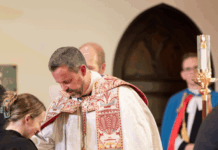Last month, during its regular December meeting, the House of Bishops published new guidance on how an existing rite, for the Affirmation of Baptismal Faith, could be used to enable transgender adults to mark their transition.
This was a direct response to a vote of the General Synod in 2017 calling for transgender people to be welcomed and affirmed in the Church and requesting the House of Bishops to consider whether nationally commended liturgical materials might be prepared to mark a person’s gender transition.
The guidance now commended by the House seeks to fulfil that remit.
The House decided that no special or new liturgy should be prepared for this purpose. Instead, it decided that existing liturgy could be used, and has provided guidance for clergy on how they could use it in this context, should they wish to do so.
The pastoral guidance is not intended as a restatement or a new statement on matters relating to gender. The guidance makes no change to the Church’s teaching. Next year the Church of England will publish a major new set of teaching and learning resources on identity, relationships, marriage and sexuality, “Living in Love and Faith”. Transgender will be among the matters covered in those resources. The pastoral guidance does not pre-empt the work of the “Living in Love and Faith” process.
What the House produced is guidance, not a new set of rules. It should be read alongside existing Notes on the use of the texts. It commends and encourages the use of An Affirmation of Baptismal Faith for the purpose of a transgender adult wishing to reaffirm their Christian faith and mark their transition; but there is no obligation on anyone to offer the rite in this or any other context. Any priest who feels unable to offer this rite in this context is free not to do so. They should find appropriate ways to offer welcome and pastoral care, as they would to all people.
William Nye, Secretary to the House of Bishops (pictured)




YES, IT DOES.
Sorry for the shouting, but it needs to be shouted.
That right there is the change, Mr. Nye. The change is the teaching that a person can transition from one sex to the other.